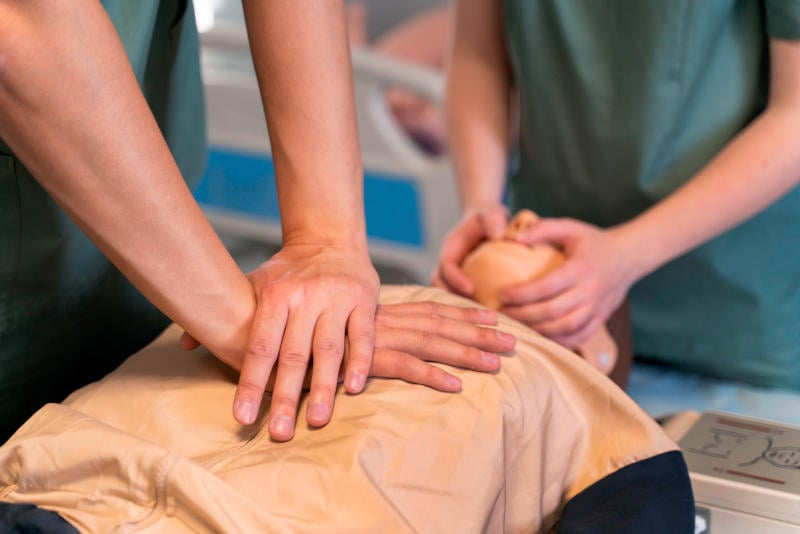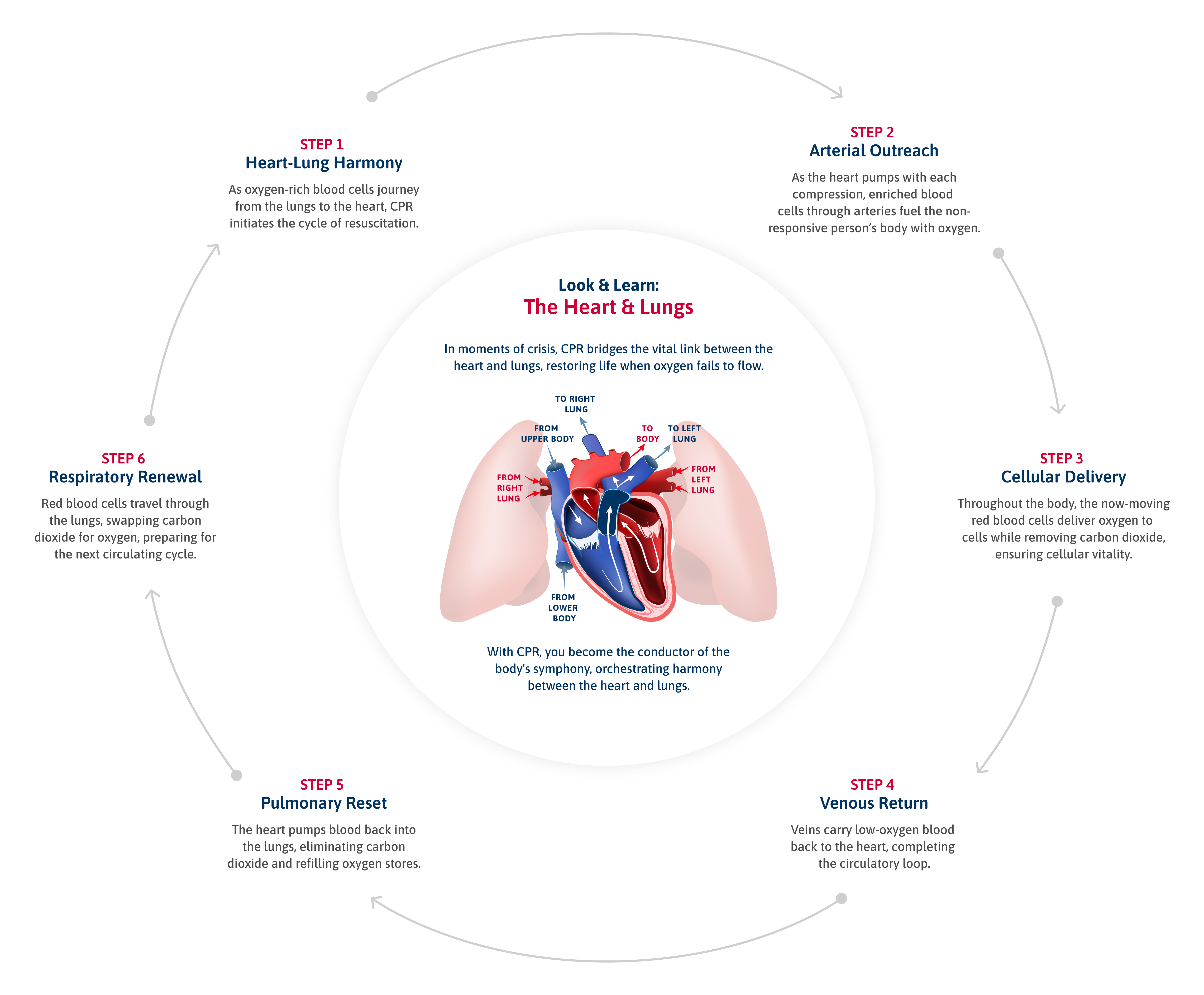Table of Contents
- What Does the C in CPR Stand For?
- What Does the P in CPR Stand For?
- What Does the R in CPR Stand For?
- Where Can I Learn More About CPR Training?
When you’ve been in the training industry as long as we have, you start to notice common themes in the questions students undergoing CPR training ask. One of the most fundamental questions beginners ask is, “What does CPR stand for, exactly?”
The most basic answer is that CPR stands for cardiopulmonary resuscitation, but there’s a lot of important information contained in those three letters.
CPR is a seven-step process of providing first aid for an unconscious person whose heart has stopped and who isn’t breathing normally.
Remember all seven steps with our mnemonic!

But beyond what CPR is, what does CPR stand for, both in terms of the acronym and the meaning behind each letter?
The three distinct components of CPR work together to make it a life-saving skill.
Read on for the answers and to find out where to learn more about CPR training.
What Does the C in CPR Stand For?
The C in CPR stands for the cardio in cardiopulmonary, referring to the heart. A person whose heart has stopped no longer has oxygen-rich red blood cells circulating throughout their body.
Without the red blood cells to transport oxygen to the body’s various tissues and organs, cell death becomes an imminent threat to the victim. According to the Cleveland Clinic, brain cell death can begin in as few as five minutes. This cell death is irreversible, which underlines the importance of providing rapid first aid via chest compressions in an emergency.
How Do Chest Compressions Actually Work?
During CPR, the aim is to manually keep oxygenated blood flowing to vital organs, such as the brain and heart, until advanced medical help arrives. This is typically achieved through a combination of chest compressions and rescue breaths.
Chest compressions involve pushing down forcefully on the person’s chest, which helps to circulate blood throughout the body. Rescue breaths involve giving breaths into the person’s mouth or nose to provide them with oxygen. This approach varies depending on the age of the victim, so ensure you’re adjusting accordingly.
What Does the P in CPR Stand For?
The P in CPR stands for the pulmonary in cardiopulmonary, which refers to the lungs. The lungs are the main organ in the respiratory system responsible for turning air into properly humidified and temperature-controlled oxygen that is transferred into your red blood cells. The effects of disturbances to this system can be seen in under a minute.

When providing CPR, the chest is compressed, which serves two functions:
- To pump the heart to restore blood flow throughout the body.
- To compress, and thus force air into, the lungs. This process can prove effective, even without the intentional rescue breaths.
Studies published by the American Heart Association Journal on compression-only CPR have found that the residual oxygen in the lungs is sufficient to increase the survivability of CPR due to cardiac arrest. While compression-only CPR can be effective, if you’re properly trained in CPR, rescue breaths provide added levels of survivability when administering CPR.
How Do the Heart & Lungs Work Together?
Together, the heart and lungs ensure that every corner of the body receives the oxygen it needs to thrive. They also makes sure that waste products are efficiently removed, keeping your body running smoothly.
The heart pumps blood through a network of arteries and veins, while the lungs oxygenate that blood and remove carbon dioxide. Deoxygenated blood from the body flows into the heart’s right side, where it’s pumped to the lungs to pick up oxygen. In the lungs, tiny air sacs called alveoli facilitate the exchange of gases: oxygen enters the bloodstream, and carbon dioxide leaves it.
Oxygen-rich blood then returns to the heart’s left side, which pumps it out to the body, delivering oxygen to cells. Simultaneously, carbon dioxide produced by cells is carried back to the lungs, where it’s exhaled out of the body.
The heart and lungs work together to ensure every cell receives the oxygen it needs.
Explore the seamless coordination between the heart and lungs with our detailed visual guide.

What Does the R in CPR Stand For?
The R in CPR stands for resuscitation, and is a good reminder that CPR aims to return the victim to consciousness. This is a key point in assessing whether a person requires emergency CPR.
If someone is successfully resuscitated, it means that their heart and breathing have been restored after a period of cardiac arrest or respiratory failure. Successful resuscitation can be a life-saving intervention and may prevent brain damage or other serious complications that can occur when vital organs are deprived of oxygen for an extended period.
After resuscitation, the person may require ongoing medical care and monitoring to ensure their continued stability and recovery. This may involve admission to a hospital or intensive care unit, depending on the severity of the initial event and any underlying medical conditions.
While not all CPR attempts are successful, trying your best is essential.
Unfortunately, not all CPR attempts are successful. The outcome of resuscitation efforts can vary depending on several factors, including the cause of the cardiac arrest or respiratory failure, the timeliness of intervention, the effectiveness of CPR and other resuscitative measures, and the overall health of the individual.
Simply trying your best in these situations is crucial. We encourage you to maintain perspective and avoid excessive self-blame in the event of an unsuccessful resuscitation attempt.
Note that CPR should never be conducted on a person who is conscious but struggling to breathe. In this case, the Heimlich maneuver would be the appropriate next step.
With CPR, we want to give the victim the best chance of survival. Check out this video that explains more about what happens when CPR doesn’t work:
The Three Types of CPR Techniques
In addition to standard CPR, advanced resuscitation techniques have been developed to tackle specific challenges in emergency situations. They aim to optimize blood flow and improve the chances of successful resuscitation.
These techniques are less commonly used compared to standard CPR methods and are typically employed in specific medical scenarios or by trained professionals in advanced resuscitation situations.
The three techniques are:
- Interposed Abdominal Compression CPR (IAC-CPR): This technique involves applying additional pressure to the abdomen during CPR compressions. It’s typically used in cardiac arrest, where additional blood flow is needed. By compressing the abdomen along with the chest, blood is squeezed from the abdominal organs, increasing blood flow back to the heart and brain.
- Open-Chest CPR: Open-chest CPR, also known as open-chest cardiac massage, involves surgically opening the chest cavity to directly massage the heart during CPR. It’s an invasive procedure typically performed in emergency settings, such as during cardiac surgery or in cases of traumatic cardiac arrest. Open-chest CPR allows for direct access to the heart, enabling more effective compression and rhythm control.
- High-Frequency Chest Compressions: While the standard compression rate for CPR is around 100-120 compressions per minute, high-frequency chest compressions may involve rates exceeding 120 compressions per minute. This technique aims to maximize blood flow to vital organs by increasing the frequency of chest compressions.
By incorporating these advanced techniques into emergency response protocols, qualified healthcare providers can enhance patient outcomes and potentially save more lives.
Where Can I Learn More About CPR Training?
Once you understand the answer to, “What does CPR stand for?,” it becomes easier to visualize what’s happening as you’re performing it. Every layperson has the ability to successfully provide CPR in an emergency, but there’s no replacement for quality CPR training.
Building your and your team’s knowledge of CPR starts with choosing the right program.
Always get your CPR training from someone with years of experience, a good reputation, and added knowledge or experience to support your training.
At ProTrainings, in addition to the highest-quality CPR training, we offer in-person, fully online, or blended CPR course options to suit all learning styles and lifestyles.
However, we understand that undergoing CPR training can sometimes evoke certain fears or concerns. To address these, we’ve prepared a video titled “The Five Fears of CPR Rescue.” This video covers common worries during CPR training and provides valuable insights to help alleviate them.
If you’re still wondering, “What does CPR stand for?,” reach out to ProTrainings today to learn more about our group and remote-staff CPR certification programs.
